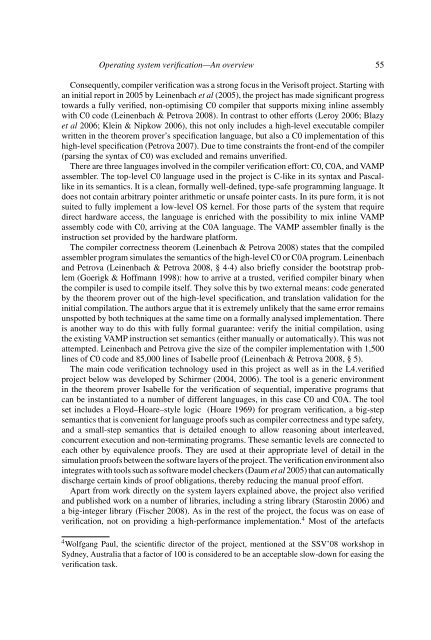Operating system verificationâAn overview
Operating system verificationâAn overview
Operating system verificationâAn overview
You also want an ePaper? Increase the reach of your titles
YUMPU automatically turns print PDFs into web optimized ePapers that Google loves.
<strong>Operating</strong> <strong>system</strong> verification—An <strong>overview</strong> 55<br />
Consequently, compiler verification was a strong focus in the Verisoft project. Starting with<br />
an initial report in 2005 by Leinenbach et al (2005), the project has made significant progress<br />
towards a fully verified, non-optimising C0 compiler that supports mixing inline assembly<br />
with C0 code (Leinenbach & Petrova 2008). In contrast to other efforts (Leroy 2006; Blazy<br />
et al 2006; Klein & Nipkow 2006), this not only includes a high-level executable compiler<br />
written in the theorem prover’s specification language, but also a C0 implementation of this<br />
high-level specification (Petrova 2007). Due to time constraints the front-end of the compiler<br />
(parsing the syntax of C0) was excluded and remains unverified.<br />
There are three languages involved in the compiler verification effort: C0, C0A, and VAMP<br />
assembler. The top-level C0 language used in the project is C-like in its syntax and Pascallike<br />
in its semantics. It is a clean, formally well-defined, type-safe programming language. It<br />
does not contain arbitrary pointer arithmetic or unsafe pointer casts. In its pure form, it is not<br />
suited to fully implement a low-level OS kernel. For those parts of the <strong>system</strong> that require<br />
direct hardware access, the language is enriched with the possibility to mix inline VAMP<br />
assembly code with C0, arriving at the C0A language. The VAMP assembler finally is the<br />
instruction set provided by the hardware platform.<br />
The compiler correctness theorem (Leinenbach & Petrova 2008) states that the compiled<br />
assembler program simulates the semantics of the high-level C0 or C0A program. Leinenbach<br />
and Petrova (Leinenbach & Petrova 2008, § 4·4) also briefly consider the bootstrap problem<br />
(Goerigk & Hoffmann 1998): how to arrive at a trusted, verified compiler binary when<br />
the compiler is used to compile itself. They solve this by two external means: code generated<br />
by the theorem prover out of the high-level specification, and translation validation for the<br />
initial compilation. The authors argue that it is extremely unlikely that the same error remains<br />
unspotted by both techniques at the same time on a formally analysed implementation. There<br />
is another way to do this with fully formal guarantee: verify the initial compilation, using<br />
the existing VAMP instruction set semantics (either manually or automatically). This was not<br />
attempted. Leinenbach and Petrova give the size of the compiler implementation with 1,500<br />
lines of C0 code and 85,000 lines of Isabelle proof (Leinenbach & Petrova 2008, § 5).<br />
The main code verification technology used in this project as well as in the L4.verified<br />
project below was developed by Schirmer (2004, 2006). The tool is a generic environment<br />
in the theorem prover Isabelle for the verification of sequential, imperative programs that<br />
can be instantiated to a number of different languages, in this case C0 and C0A. The tool<br />
set includes a Floyd–Hoare–style logic (Hoare 1969) for program verification, a big-step<br />
semantics that is convenient for language proofs such as compiler correctness and type safety,<br />
and a small-step semantics that is detailed enough to allow reasoning about interleaved,<br />
concurrent execution and non-terminating programs. These semantic levels are connected to<br />
each other by equivalence proofs. They are used at their appropriate level of detail in the<br />
simulation proofs between the software layers of the project. The verification environment also<br />
integrates with tools such as software model checkers (Daum et al 2005) that can automatically<br />
discharge certain kinds of proof obligations, thereby reducing the manual proof effort.<br />
Apart from work directly on the <strong>system</strong> layers explained above, the project also verified<br />
and published work on a number of libraries, including a string library (Starostin 2006) and<br />
a big-integer library (Fischer 2008). As in the rest of the project, the focus was on ease of<br />
verification, not on providing a high-performance implementation. 4 Most of the artefacts<br />
4 Wolfgang Paul, the scientific director of the project, mentioned at the SSV’08 workshop in<br />
Sydney, Australia that a factor of 100 is considered to be an acceptable slow-down for easing the<br />
verification task.
















